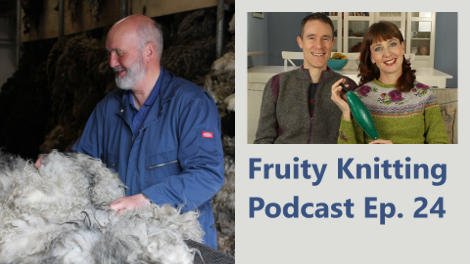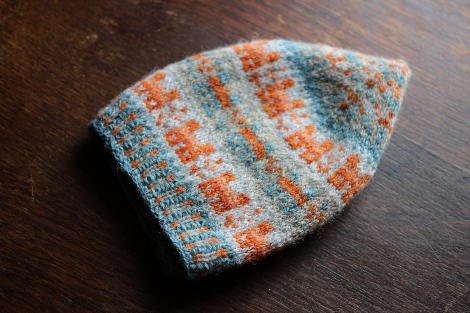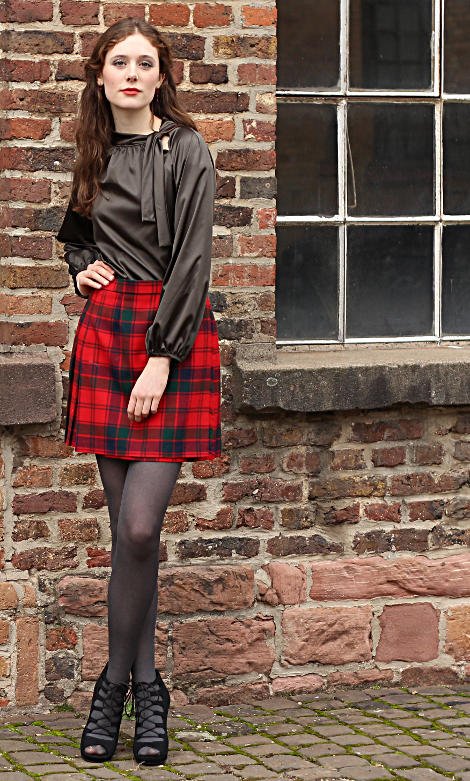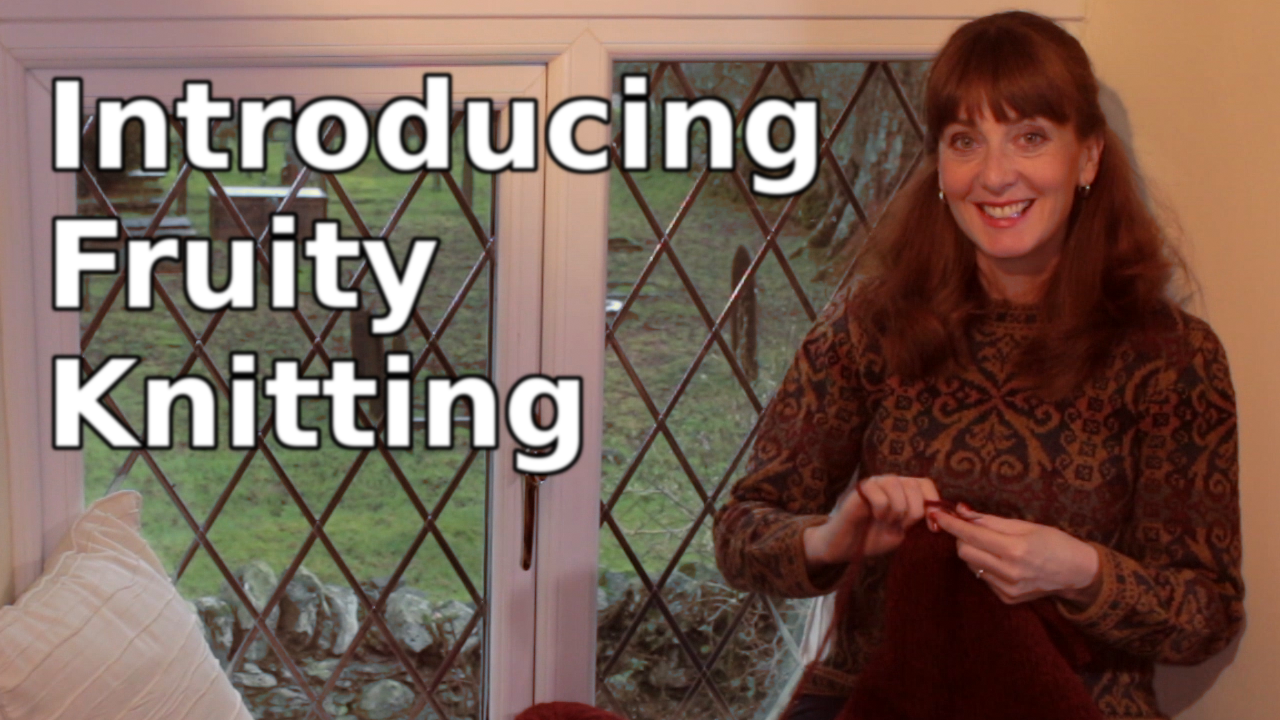Fruity Knitting Podcast Episode 24 brings you Oliver Henry, the “Wool Man” of Shetland’s Jamieson and Smith. Oliver takes us from the past to the present, sharing his stories of the cultural role of wool and knitting in the community, and telling us about recent developments in the yarns produced and other uses for the wool. We stay on Shetland for Knitters of the World, where our guest is Ella Gordon, 2016 Patron of the Shetland Wool Week and creator of designs including the Crofthoose Hat. We get a closer look at a traditional knitting belt, and there’s some progress on Andrew’s Drachenfels Shawl by Melanie Berg.

Oliver Henry from Jamieson and Smith Shetland Wool Brokers
Oliver Henry was born on Shetland into a fishing family, but quickly moved towards the wool industry after helping out on his uncle’s farm. A tendency to sea-sickness gave an additional push towards a more land-based occupation. Oliver found his place at Jamieson and Smith Shetland Wool Brokers, where he has now worked for nearly 50 years. Oliver is widely respected for his knowledge of Shetland sheep and their fleeces, and is responsible for sorting the fleeces into the various grade for different uses.

Oliver is passionate about the role of the wool and knitting industry in Shetland and is dedicated to supporting the crofters, or small farmers, on the island. Jamieson and Smith are the main purchasers of wool grown on Shetland, and all yarns produced by Jamieson and Smith only use locally grown wool.

Shetland sheep are a mixture of two breeds and display significant variation in their fleeces. Hand sorting is required to ensure the high quality of the finest wools is not affected by guard hairs which can be found on some parts of the sheep. Coarser wools are now separated and used for applications such as carpets and mats, reducing waste and increasing the returns for the local crofters.

Jamieson and Smith has worked together with the Shetland Museum to analyse garments found in their collections. The Jamieson and Smith Shetland Heritage yarns are spun to reproduce the characteristics of the handspun yarns found in traditional Fair Isle garments. There are coloured yarns, but the “Naturals” are undyed, using the different natural shades of the Shetland sheep.

You can see what Oliver Henry is up to at:
Ella Gordon – Knitters of the World
Ella Gordon is a younger generation Shetlander, and in 2012 graduated from the Shetland Collage with a degree in Contemporary Textiles. She has set up a small business as a designer and in both machine and hand-knitted garments.

In 2016 Ella served as Patron to the Shetland Wool Week. She took her hallmark design of a Shetland farmhouse or “crofthoose” and created the Crofthoose Hat as the Shetland Wool Week 2016 official pattern.

Find Ella Gordon at:
- ellagordondesigns.co.uk
- @ellalcgordon on Instagram
Drachenfels Shawl by Melanie Berg
My Drachenfels Shawl is starting to take shape. I’m enjoying knitting it – there are a few technical bits – increases and decreases, a little concentration to keep track of where I am, but it is a safe step up from what I have done so far. I’m using the recommended Cheeky Merino Joy from Rosy Green Wool – organic merino wool sourced from Patagonia.

Drachenfels, meaning “Dragon’s Rock” or cliff, is a hill near the Rhine River, just south of Bonn. It has been quarried for trachyte (a type of stone) since the Roman times, its location close to the river allowing easy transportation by barge.

One of the places that this rock has ended up is the Cologne Cathedral. I don’t actually travel a lot, but Cologne is one place that I have passed through fairly frequently. The Cathedral is worth a visit – it is simply impressive. If you get a tour you will hear that the two spires that you can see here are actually very different heights – I forget exactly how much, but it’s a lot. You can’t see the difference from the ground, but that just shows again how high this structure is. Cologne shows its respect for the Cathedral by not allowing any buildings to approach it in height.
Before you book your flights, be warned that all of Germany’s historic structures generally have some amount of scaffolding on at any time. I’ve mostly hidden it here, but you can just see a little bit popping out from behind my head.
Catherine Parr and the Knitting Belt
Andrea has acquired a real Shetland knitting belt, together with a set of 40 cm double pointed needles. Andrea has mentioned that she needs some practice to get them under control and is looking into getting some guidance from an expert. We’ll keep you informed.

What you can see here is the sleeves – done two at a time to ensure that the increases match, even if they’re not exactly done as specified by the pattern.
Madeleine gets a blouse
Andrea completed the blouse, but even with a few well-targeted modifications, the verdict was negative. Officially, the garment has been handed on to Madeleine – see below – although I did notice that it was Andrea wearing it today. Maybe it just needs a bit of time. (Update: Andrea has been wearing the blouse the last two days…)

Edinburgh Yarn Festival

Andrea and I will be attending the Edinburgh Yarn Festival and would be thrilled to meet you there. The Podcaster Lounge is a space set aside where viewers (and listeners) and podcasters can meet up, and we will be there from 1 to 2 pm on Friday and Saturday. Come and say hello!
Andrea and Madeleine had a short holiday in Scotland shortly after we moved to Germany, but I have never been there. My great great grandfather migrated from Kilrenny, Scotland to Australia in 1852 (or 1853).


Music Credits
- Montana Skies, Tunnels, Creative Commons Attribution-Noncommercial-ShareAlike 3.0
- Sláinte, Album: Cup of Tea, Creative Commons Attribution-ShareAlike 3.0
- Britches Full of Stitches. Munster Bank. Bill Sullivan’s (The A Polkas)
- Lark in the Morning. The Atholl Highlanders
- Claude Debussy, Rêverie, performed by Simone Renzi, Creative Commons Attribution-NonCommercial 3.0
- J. S. Bach, The Well Tempered Klavier, Prelude No. 3 in C-Sharp major, BWV 848, performed by Kimiko Ishizaka, Creative Commons Attribution 3.0



Pingback: Fruity Knitting Podcast
Thank you again for the fantastic work you do. These episodes about wool and quality of wool have teached me so much. Speciall i am now aware of that the quality of wool is important for what type of garment you are making. I am knitting on Selbu mittens, Norwegian tradition mittens. I remember from our looong skiing expeditions that I never had cold hands. Even if the wool got wet, I can not remember that cold hands was an issue. I know understand that the wool that was used had these quality that you will know call gentle wool, but it served its purspose. It was not “fine wool” but not inferior, because it had a whole different use. I know have bought yarn from Selbu Spinneri, and i am so happy. Making my childhoods mittens again..
Thank you for your last episodes about woold!!!!!
Sorry I must correct myself. The mittens did not have the quality that you will call gentle wool, but more “hard”.
The first master builder of the Cologne Cathedral in 1248 made a pact with the devil…when ever the Cathedral is called to be finished, the master builder’s soul should belong to the devil…well, we take care this day never comes. ?That’s why there is constant renewing and building at the Cathedral. Of cause time, pollution and errosion makes it important to repair and replace stones and figurines.
I wish all of you, who decide to visit my hometown Cologne a pleasant stay.
Best wishes,
Silke
Silke – I love this. I think all German builders – past and present – are safe from the devil.
I am very inspired by your Podcasts, esp interviews. This morning I made a knitting belt from my leather stash, to prepare learning cables and Fair Isle. Thank you for such inspirational podcasts. I am looking forward for more good stories, interviews, inspiring fiber artists.
Cindy – that is cool that you made your own knitting belt. (I had the same thought – although I’ve never done anything with leather.) Post a picture to the Fruity Knitting Ravelry group – I’m sure people would love to see it.